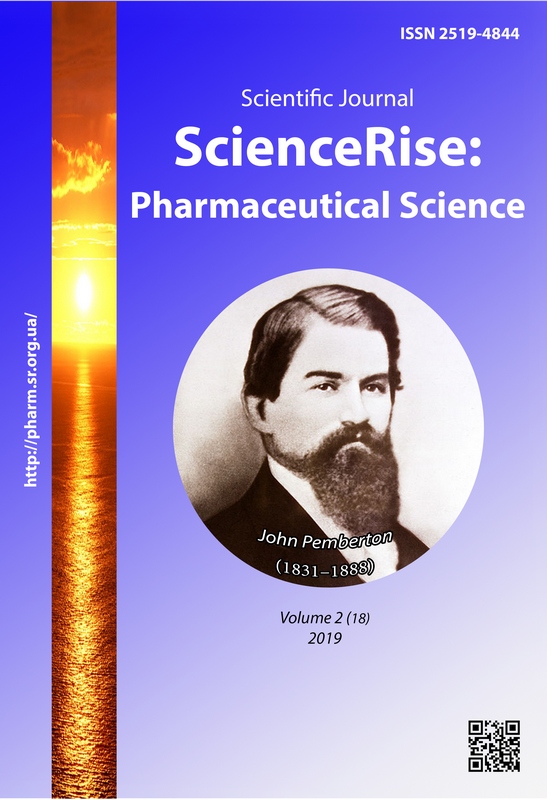Development of the method of simultaneous quantitative determination of loratadine and auxuilary substances in the combined syrup "Loratadin+"
DOI:
https://doi.org/10.15587/2519-4852.2019.169511Keywords:
loratadine, methyl parahydroxybenzoate, propyl parahydroxybenzoate, quantitative determination, combined drugs, hepatoprotective actionAbstract
Aim. The aim of the present study was to develop a method for the simultaneous determination of loratadine and auxiliary substances - methyl parahydroxybenzoate and propyl parahydroxybenzoate in the combined "Loratadine+" syrup in the presence of a bupleurum aurus grass extract.
Materials and methods. Liquid chromatography separation was performed using a Shimadzu Nexera X2 LC-30AD HPLC system (Shimadzu, Japan) composed of a quaternary pump, an on-line degasser, a column temperature controller, the SIL-30AC autosampler (Shimadzu, Japan); the CTO-20AC thermostat (Shimadzu, Japan) as well as the SPD-M20A diode array detector (DAD).
Results and discussion. Identification of the main component and impurities in the combined syrup was performed by determining the retention times of peaks of loratadine, methyl parahydroxybenzoate and propyl parahydroxybenzoate on the chromatogram of the test solution, obtained by quantifying them, which coincided with the retention times of the corresponding peaks on the chromatogram of the reference solution.
When developing a quantitative determination method, it was found that using the gradient mode, the best separation between the compounds was observed, the separation coefficient between the peaks of methyl parahydroxybenzoate and the peaks closest to it became more than 2.5, in the case of propyl parahydroxybenzoate this index was more than 3.
To confirm the correctness of the proposed method, validation studies were carried out in accordance with the requirements of SPHU. It was established that the uncertainty of sample preparation is 1.5 % for loratadine, 1.47 % for methyl parahydroxybenzoate, and 1.53 % for propyl parahydroxybenzoate, which does not exceed the acceptance criteria. The specificity of the technique was confirmed by comparing the chromatograms of the reference solution, the test solution and the chromatogram of the blank solution. Requirements for the linearity of the method were performed over the entire range of concentrations for loratadine and both excipients. The correlation coefficients were 0.9999, 0.9999 and 0.9995, respectively. The correctness of the technique was carried out according to two criteria - practical and statistical insignificance, which were determined in the course of experimental studies. The results of the assessment of intralaboratory precision showed that the obtained values of the confidence interval of the average result to the criteria of acceptability. Based on the results of the determination of robustness, it was found that for optimal chromatographic conditions, a freshly prepared reference solution can be used within 24 hours.
Conclusions. A method was developed for the simultaneous quantitative determination of loratadine and auxiliary substances - methyl parahydroxybenzoate and propyl parahydroxybenzoate in the syrup of "Loratadine+". The conditions that allow to correctly determining all the components in the presence of a bupleurum aurus grass extract were determined. The correctness of the methodology is confirmed by validation studies
References
- Arshad, H., Khan, A., Assad, U., Kittaneh, M., Berkelhammer, C. (2016). Antihistamine-Induced Hepatitis: 2 Cases Involving Loratidine. Case Reports in Hepatology, 2016, 1–2. doi: http://doi.org/10.1155/2016/6890313
- Breidak, O. O., Kuzminov, O. B. (2015). Otsinka kumuliatyvnoi aktyvnosti diazolinu, loratydynu ta dezloratydynu u pidhostromu ekspyrementi na bilykh myshakh. Biolohiia tvaryn, 17 (4), 178.
- Gubergic, N. B., Fomenko, P. G., Lukashevich, G. M., Golubova, O. A. (2012). Farmakoterapevticheskie effekty i klinicheskie vozmozhnosti etalonnogo preparata silimarina. FARMATЕKA, 2, 24–31.
- Pegova, R. A., Vorobeva, O. A., Kolchik, O. V., Bolshakova, A. Е., Zhilcova, O. Е., Melnikova, N. B. (2014). Rastitelnye masla. Sostav i perspektivy ispolzovaniia masla semian tykvy Cucurbita Pepo v terapii (obzor). Medicinskii almanakh, 2 (32), 127–135.
- Asadi-Samani, M., Kafash-Farkhad, N., Azimi, N., Fasihi, A., Alinia-Ahandani, E., Rafieian-Kopaei, M. (2015). Medicinal plants with hepatoprotective activity in Iranian folk medicine. Asian Pacific Journal of Tropical Biomedicine, 5 (2), 146–157. doi: http://doi.org/10.1016/s2221-1691(15)30159-3
- Zhuravlova, L. V., Kryvonosova, O. M. (2013). Porivnialna kharakterystyka hepatoprotektornykh zasobiv: kliuch do ratsionalnoho zastosuvannia. Suchasna hastroenterolohiia, 4 (72), 35–41.
- Thompson, M., Jaiswal, Y., Wang, I., Williams, L. (2017). Hepatotoxicity: Treatment, causes and applications of medicinal plants as therapeutic agents. The Journal of Phytopharmacology, 6 (3), 186–193.
- Majee, C., Mazumder, R., Choudhary, A. N. (2019). Medicinal plants with anti-ulcer and hepatoprotective activity. International Journal of pharmaceutical sciences and research, 10 (1), 1–11. doi: http://doi.org/10.13040/ijpsr.0975-8232.10(1).1-11
- Deshwal, N., Sharma, A. K., Sharma, P. (2011). Review on hepatoprotective plants. International Journal of Pharmaceutical Sciences Review and Research, 7 (1), 15–26.
- Jehangir, A., Nagi, A. H., Shahzad, M. S., Azam, Z. (2010). The hepatoprotective effect of Cassia fistula leaves in Isoniazid and rifampicin induced hepatotoxicity in rodents. Biomedica, 26, 25–29.
- Björnsson, E. (2016). Hepatotoxicity by Drugs: The Most Common Implicated Agents. International Journal of Molecular Sciences, 17 (2), 224. doi: http://doi.org/10.3390/ijms17020224
- Naboka, О. І., Khouari, S., Glushchenko, А. V., Georgiyants, V. A. (2014). Antioxidation properties of extracts of aerial part of Bupleurum aureum, Hill-growing soltword herb, Fumaria Schleicheri and Cynara scolymus in vitro and in vivo Journal of Chemical and Pharmaceutical Research, 6 (7), 172–177.
- Glushchenko, A., Vladymyrova, I., Georgiyants, V. (2018). The substantiation of the selection of medicinal plants and their rational application in diseases of the hepatobiliary system. ScienceRise: Pharmaceutical Science, 2 (12), 9–16. doi: http://doi.org/10.15587/2519-4852.2018.129642
- Glushchenko, A. V., Puliaev, D. S., Georgiianc, V. A., Naboka, O. I. (2016). Sposob vvedeniia sukhogo ekstrakta volodushki zolotistoi v sirop «Loratadin». Vestnik farmacii, 4 (74), 6–9.
- Korobko, D. B., Poliak, O. B., Lohoida, L. S., Zarivna, N. O., Semianiv, O. V. (2014). Rozrobka i validatsiia metodyk identyfikatsii loratadynu v tabletkakh. Aktualni pytannia farmatsevtychnoi i medychnoi nauky ta praktyky, 1 (14), 55–58.
- Florin, A., Grigoriv, I. C., Ciobanu, C. (2016). Validation and Application of a RP-HPLC Method with UV Detection for Loratadine Determination. Revista de Chimie-Bucharest-Original Edition, 67 (6), 1227–1231.
Downloads
Published
How to Cite
Issue
Section
License
Copyright (c) 2019 Alla Glushchenko, Ivan Bezruk, Liudas Ivanauskas, Victoriya Georgiyants

This work is licensed under a Creative Commons Attribution 4.0 International License.
Our journal abides by the Creative Commons CC BY copyright rights and permissions for open access journals.








